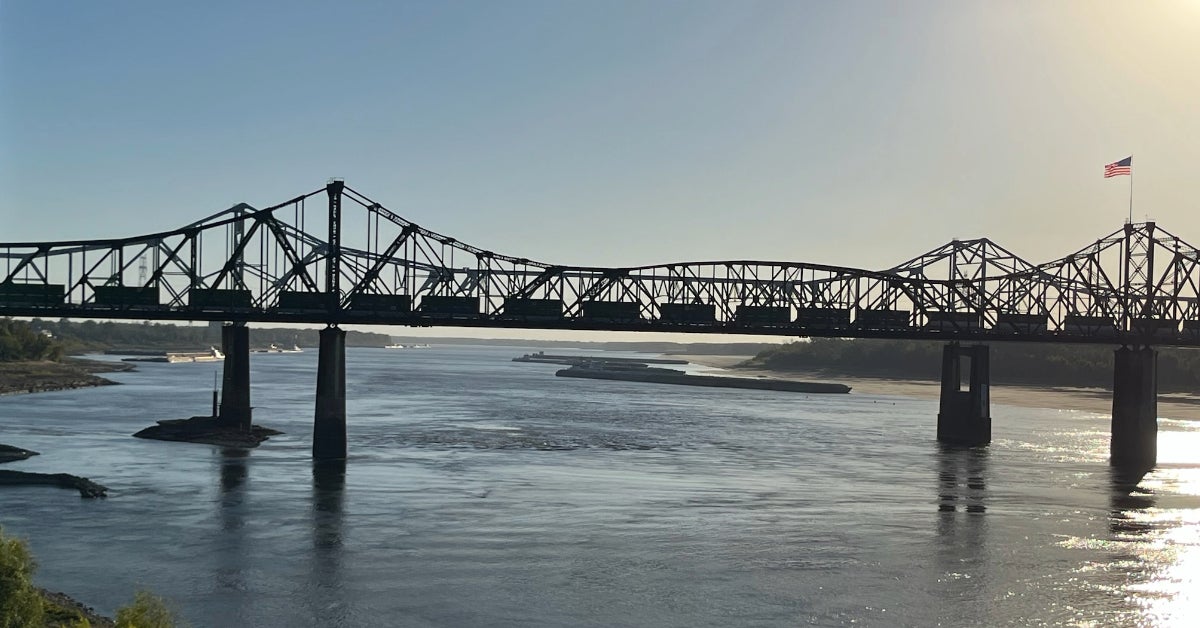Vicksburg’s Mississippi River Bridge shifting due to low-water events
Published 3:22 pm Thursday, October 26, 2023

- Low water shows exposed piers of the Old Highway 80 Bridge over the Mississippi River. (Photo by Tracye Prewitt | The Vicksburg Post)
The Old Highway 80 Bridge colloquially known as the Mississippi River Bridge at Vicksburg has shifted west by 1.5 inches in the past year due to repeated low-water events.
Herman Smith, superintendent of the Vicksburg Bridge Commission of Warren County, said shifts are nothing new for a structure of this magnitude, but noted that 1.5 inches in a year is significant. The shift is caused by low river levels and mainly impacts Piers 2 and 3 on the bridge.
“It’s been shifting ever since it was built. It moves when the water goes down,” Smith said. “The fault line runs right near the bridge, and it affects the I-20 bridge as much as ours. That’s kind of how we discovered it.”
When the bridge was constructed, designers were not aware that the New Madrid fault line runs along the Mississippi River and through Vicksburg. The fault runs south of Interstate 20 and goes through the parking lot of Ameristar Casino and up to North Frontage Road, Smith said.
“The two tectonic plates move when the water is no longer saturating the sand,” he said. “When it doesn’t have that water compressing it, the soil starts shifting.”
Last year, Smith said his office got a call from the Louisiana Department of Transportation and Development (LDOTD), which manages the Interstate 20 bridge at Vicksburg. The department reported shifting of piers on its bridge and asked Smith if he’d seen similar shifting at the Old Mississippi River Bridge.
Erin Buchanan, LDOTD public information officer, said Thursday the bridge shifts were not alarming. In fact, she said, there was work earlier in the year to address some shifting concerns.
“In general, bridges such as this one are designed to be flexible to accommodate for events such as wind, temperature changes and to be able to appropriately bear the weight of the loads crossing the structure,” Buchanan said. “In April 2023, DOTD performed finger joint adjustments to allow for greater movement of the bridge. As the structure moves naturally, repairs on various components of the bridge become necessary and we monitor those needs regularly.
“Finger joints are an integral part of the bridge, providing support to vehicles as they travel across, as well as preventing water and other material from impacting the steel support girders and bearings.”
Similar plans are in place for the Old Mississippi River Bridge, Smith said. Engineer Rudy McLellan, who has worked on the bridge for more than 30 years and is currently employed by Huval and Associates in Baton Rouge, has already designed plans to address the shifting piers.
Soon, the project will be put out for bids. While the repair project will result in some closures for railway operators, Smith said at the moment there is no danger in using the bridge.
“Pier 2 – and it’s not anything new to us – has been shifting since it was built. It’s moved over 30 inches west since it was built,” Smith said. “You don’t have to worry (about the safety of the structure), because they already made some repairs last year because of the movement.
“No one has to worry because we have an eye on it. We take measurements often and the computer takes them and can predict where it moves,” he added. “We’re fortunate at the Vicksburg Bridge Commission because we have a crew here who monitor it every day.”
Buchanan had similar comments about the Interstate 20 bridge — one of the most widely traveled thoroughfares in the United States.
“Motorists should keep in mind that the bridge remains safe for travel as these are naturally occurring events and we continually monitor our structures for any maintenance needs,” Buchanan said.
The Mississippi River remains low at -0.17 feet as of 3 p.m. Thursday, but will rise above zero for the first time in more than a week on Friday.





